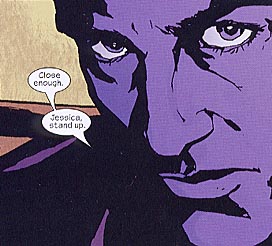 Written by Brian Michael Bendis
Written by Brian Michael Bendis
Art by Michael Gaydos, Rick Mays, Mark Bagley, and Art Thibert
176 pages, color
Published by MAX/Marvel Comics
Alias was the first ongoing series in Marvel’s MAX Comics imprint, books intended for older readers. After 28 issues it came to an end, although a non-MAX version continues in the form of The Pulse. What’s interesting to me is not so much that creator Brian Michael Bendis chose to end the book, but in the manner he did so. Sometimes, you see, that fourth wall is there for a reason.
Jessica Jones wasn’t always a private investigator. Once she was a costumed superhero named Jewel who stopped bad guys in their tracks. Then she encountered Mr. Killgrave, aka the Purple Man, and suddenly her life turned upside down. Now, years later, Jessica has a chance to confront the man who destroyed her life—but is she really ready to do so?
 I’ll get the easy part out of the way first. Alias Vol. 4 is really two different stories, and the first one—how Jessica got her powers as a high school student—is probably my favorite story in the entire run on Alias. It’s funny, it’s clever, and the characterization of Jessica is so perfect it makes you wonder if Bendis somehow once was a girl in high school. The rest of the book, though, is about Jessica’s encounters with the Purple Man in both the past and the present, and that’s a bit heavier. For the most part, I was impressed with Bendis’s writing here; he takes a goofy-named villain, takes his power of mind control to a chilling extreme, and runs with it. Killgrave the Purple Man is terrifying here in the way Bendis has him destroying people’s lives left and right, and at first I was really ready to proclaim this entire compilation a real winner. There’s a strong conclusion to the Purple Man story, and what could have been a deus ex machina solution is still one that ultimately depends on the willpower and choices of Jessica Jones, not an outside force. With that, we’re all good.
I’ll get the easy part out of the way first. Alias Vol. 4 is really two different stories, and the first one—how Jessica got her powers as a high school student—is probably my favorite story in the entire run on Alias. It’s funny, it’s clever, and the characterization of Jessica is so perfect it makes you wonder if Bendis somehow once was a girl in high school. The rest of the book, though, is about Jessica’s encounters with the Purple Man in both the past and the present, and that’s a bit heavier. For the most part, I was impressed with Bendis’s writing here; he takes a goofy-named villain, takes his power of mind control to a chilling extreme, and runs with it. Killgrave the Purple Man is terrifying here in the way Bendis has him destroying people’s lives left and right, and at first I was really ready to proclaim this entire compilation a real winner. There’s a strong conclusion to the Purple Man story, and what could have been a deus ex machina solution is still one that ultimately depends on the willpower and choices of Jessica Jones, not an outside force. With that, we’re all good.
However, there’s one element in Alias Vol. 4 that actually made me stop and put down the book for several minutes, and that’s the “breaking of the fourth wall”, or in other words a character talking to the audience and understanding his own status as a comic book character. This is by no means the first time this has happened in a comic, of course. Grant Morrison writing himself into the conclusion of his run on Animal Man was a perfect culmination of all of the plot elements and themes that he’d woven into the comic over the past two years, questioning the nature of reality and gods. Coming from an entirely different direction, John Byrne’s tenures on The Sensational She-Hulk did it for a laugh, having She-Hulk tear through pages and walk across advertisements to get to a better part of the story, or bicker with Byrne on story direction. Both of these had clear, defining purposes, even if they approached the idea from very different directions. But that’s the real problem with this device being used in Alias; it doesn’t seem to have a real purpose, and in fact seems to undercut Bendis’s story. Having Killgrave understand that he’s a comic book character seems to have one of two possible options available. The first option is that Killgrave does have a greater understanding than the rest of the world, that he does know the truth. Doing that undercuts his motives, though, and makes him less of a menace. If he knows that he’s just a comic book character, then somehow it’s easier to understand why he’s wreaking such havoc to his surroundings, because he knows that they’re all fictional and no one’s life really means anything. Suddenly this very terrifying, dangerous character isn’t so terrifying, because he knows he’s not really killing or devastating real people, but just constructs. In one fell swoop, all the menace that Bendis created is gone. The second option isn’t much better, in which Killgrave is genuinely insane. If that’s the case, then fair enough, he’s gone off the deep end. But to do so in such a manner that distracts the reader from the story also backfires, because you’re no longer thinking, “Oh wow, this guy is really terrifyingly creepy” but instead “Gosh, I wonder if he really knows that he’s a comic book character, or if he’s just crazy?” In the end, it’s something that genuinely undercuts the menace of Alias, and it’s a real pity because up until then it was doing so well.
 Regardless of if Killgrave does or doesn’t think he’s a comic book character, he (and everyone else in the book) is certainly very well drawn. Michael Gaydos’s final run on the book is fantastic, with some really creepy shots of Killgrave staring at Jessica with his dead eyes, or Jessica’s reactions to what’s happening to her. So much of Alias is about that emotional roller coaster that the characters go through, and Gaydos really nails that reaction. Using Mark Bagley and Rick Mays (with some inks by Art Thibert) for the two “special” art sequences was a nice touch as well; there’s a sharp contrast between the superhero and manga influences in these two artists’s works and Gaydos’s, and it makes these flashbacks and mental journeys stand out as something out of the ordinary.
Regardless of if Killgrave does or doesn’t think he’s a comic book character, he (and everyone else in the book) is certainly very well drawn. Michael Gaydos’s final run on the book is fantastic, with some really creepy shots of Killgrave staring at Jessica with his dead eyes, or Jessica’s reactions to what’s happening to her. So much of Alias is about that emotional roller coaster that the characters go through, and Gaydos really nails that reaction. Using Mark Bagley and Rick Mays (with some inks by Art Thibert) for the two “special” art sequences was a nice touch as well; there’s a sharp contrast between the superhero and manga influences in these two artists’s works and Gaydos’s, and it makes these flashbacks and mental journeys stand out as something out of the ordinary.
It’s a shame, because the conclusion of Alias should have built itself up more and more to a fantastic ending, and instead there’s this massive stumble about two-thirds of the way through. That said, the final confrontation between Jessica and Killgrave was fantastic, and it almost redeemed Alias Vol. 4. She and the book deserved a better overall conclusion, but I’m glad that final issue was there. I’ll miss the free-swearing Jessica Jones; hopefully the non-Mature Readers version of her in The Pulse won’t disappoint.
Purchase Links:
